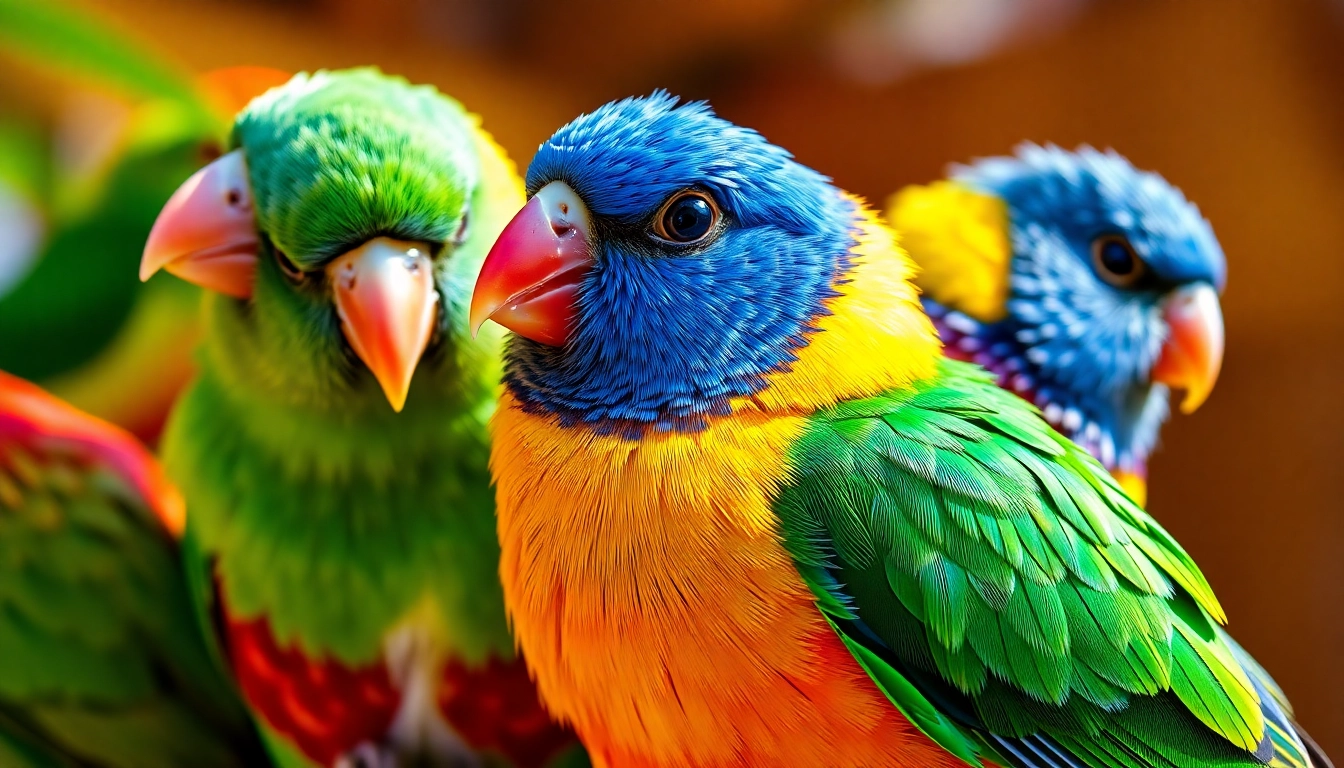Understanding the Basics of Pet Birds
Owning a pet bird can be a rewarding experience that brings joy, liveliness, and companionship to your home. With a wide variety of species available, each with its unique behaviors, care requirements, and personalities, selecting the right pet bird involves understanding the fundamentals of avian care, species differences, and lifestyle considerations. Whether you’re a first-time bird owner or looking to expand your avian family, this comprehensive guide aims to equip you with the knowledge needed to make informed decisions and provide optimal care for your feathered friends.
Popular Species for Beginners
When venturing into the world of pet birds, choosing a beginner-friendly species is essential to ensure a rewarding ownership experience and to reduce the risks associated with complex care requirements. Among the most popular beginner birds are the parakeet (also known as budgerigar), cockatiel, canary, finch, and lovebird. These species are renowned for their adaptability, manageable size, and generally less demanding care routines.
For instance, the pet birds like parakeets are highly social, relatively inexpensive, and have a lifespan of approximately 6-10 years, making them accessible choices for many households. Cockatiels, slightly larger and more expressive, are known for their affectionate nature and ability to mimic sounds, providing engaging companionship without requiring excessive maintenance. Finches and canaries are also excellent choices, particularly for those interested in bird song and minimal handling. They are usually housed in pairs or small flocks and are less prone to behavioral issues that can occur with more complex species.
Understanding the behavior and specific needs of these birds is crucial. For example, budgerigars need daily social interaction and mental stimulation, while finches thrive in group settings and require a spacious cage to accommodate their active nature. Recognizing these nuances allows new owners to select species aligned with their daily routines, living environments, and capacity to provide care.
Choosing the Right Pet Bird for Your Lifestyle
The diversity of pet bird species means that matching a bird’s temperament and care needs with your lifestyle is key to a successful partnership. Consider factors such as available space, time commitment, activity levels, and social preferences. For example, if you have a busy work schedule and limited time for social interaction, self-reliant species like the Poicephalus parrots might be suitable since they can entertain themselves and do not require constant attention.
Conversely, if you desire a highly interactive and talkative companion, species like the African grey parrots and Quaker parrots are known for their intelligence and ability to mimic human speech. However, such birds require significant mental stimulation and social interaction to prevent boredom and behavioral issues.
Additionally, evaluating your environment is important. If you live in a small apartment, a smaller bird like a lovebird or a pair of finches may be ideal, while larger spaces can accommodate more expansive cages for large parrots such as macaws or cockatoos. Your choice should also integrate considerations about noise levels, as some species like cockatoos and macaws are very loud and may not be suitable for close neighbors or noise-sensitive environments.
Always assess your willingness to provide ongoing enrichment, diet maintenance, and veterinary care. The right match ensures your pet bird thrives and fosters a deep, lifelong bond.
Essential Bird Care Supplies and Setup
Proper setup and supplies are fundamental to the health and happiness of pet birds. A suitable cage should be spacious enough to allow free movement, equipped with perches of varying diameters to promote foot health, and lined with non-toxic, easy-to-clean materials. Perches should be made from safe woods or natural branches, avoiding plastic or metal that can cause injury.
Feeding dishes, toys, and enrichment items such as mirrors, bells, and foraging toys are essential to stimulate natural behaviors. Lighting also plays a vital role; providing a day/night cycle with access to natural light or full-spectrum lighting supports their circadian rhythms and overall well-being.
Maintain a clean environment by regularly cleaning the cage, replacing substrate, and sanitizing food and water containers. Ensuring proper temperature, humidity, and ventilation further enhances their health. Access to fresh water at all times, a balanced diet rich in pellets, seeds, fresh fruits, vegetables, and occasional treats, promotes longevity and vitality.
Investing in veterinary-grade supplies such as calcium supplements, bird-safe cleaning agents, and health monitoring tools can prevent common ailments and catch health issues early.
Care Tips for Healthy and Happy Pet Birds
Diet and Nutrition Essentials
Feeding your bird a balanced diet is vital for maintaining their health, feather quality, and longevity. A proper diet combines high-quality commercial pellets with fresh fruits and vegetables, and occasional seeds or grains. Pellets are formulated to meet all nutritional needs, reducing the risk of deficits associated with seed-only diets, which are often high-fat and lack variety.
Healthy options include leafy greens like spinach and kale, colorful bell peppers, carrots, and fruits such as apples, berries, and melons. Avoid avocado, chocolate, caffeine, alcohol, and salty or sugary processed foods, as these can be toxic to birds.
Supplementation with calcium sources like cuttlebones or mineral blocks supports bone and beak health. Fresh, clean water should always be available, and food and water dishes require daily cleaning to prevent bacterial growth.
Monitoring weight and plumage condition, along with feeding a varied diet, helps prevent nutritional deficiencies that can cause health issues like feather plucking, obesity, or metabolic diseases.
Providing an Enriching Environment
Birds are intelligent and social creatures that require mental and physical stimulation. Enrichment can be achieved through a variety of toys, foraging opportunities, and social interaction. Rotate toys regularly to keep their environment engaging and prevent boredom.
Perches of different textures and diameters help maintain foot health and promote natural grasping behaviors. Creating safe spaces for flying or climbing, and encouraging interactive playtime outside the cage under supervision, can enhance their physical health and mental sharpness.
Sounds, music, and human interaction fulfill social needs, especially for species known for their vocalizations. Training sessions focused on clicker training or teaching tricks foster mental stimulation and deepen the bond with your bird.
Overall, a well-enriched environment minimizes destructive behaviors like feather plucking and promotes overall happiness and well-being.
Regular Health Checks and Grooming
Routine veterinary visits are essential to detect early signs of illness such as respiratory infections, parasites, or nutritional deficiencies. Regular nail trims, beak checks, and bathings are also part of standard grooming practices.
Providing opportunities for bathing—either via misting, shallow baths, or dedicated bathing dishes—keeps skin and feathers healthy. Dust baths with proper, bird-safe dust help with feather maintenance and parasite control.
Maintaining a clean living space, ensuring proper cage hygiene, and observing behavioral or physical changes can indicate health issues that warrant veterinary attention.
Understanding the signs of common ailments and having a relationship with an avian veterinarian ensures your pet remains healthy and energetic over their lifespan.
Training and Socializing Pet Birds
Building Trust and Companionship
Trust-building is paramount when establishing a bond with your pet bird. Approaching gently, speaking softly, and respecting their space help foster comfort and confidence. Offer treats and spend time near the cage, gradually introducing handling and interaction.
Reward-based training encourages positive behaviors. Starting with simple commands, like stepping onto your hand, and gradually advancing to trick training, enhances mental stimulation and deepens mutual trust.
Patience is key, as different species and individual birds may have varied comfort levels with handling and social interaction. Consistent routines and gentle behavior ensure a strong, affectionate bond.
Teaching Tricks and Communication
Many intelligent bird species can learn to perform tricks, mimic words, or respond to commands. Using positive reinforcement techniques like clicker training can help teach skills such as target training, fetch, or singing specific sounds.
Consistent repetition, patience, and rewarding desired behaviors with treats or praise promote learning. Recording progress and maintaining a calm demeanor create an optimal environment for training success.
Vocal training also entails teaching your bird to mimic words or sounds, which requires patience and regular practice. This form of interaction enriches their cognitive abilities and enhances your connection.
Managing Behavioral Challenges Effectively
Behavioral issues such as biting, screaming, or feather plucking often stem from stress, boredom, or health issues. Addressing these requires identifying root causes and implementing behavioral modification strategies.
Providing sufficient enrichment, social interaction, and a stable environment reduces stress-induced behaviors. Establishing consistent routines helps create a sense of security.
If biting occurs, observing triggers like fear or territoriality and retraining with gentle handling can mitigate aggressive responses. For screaming, ensuring adequate mental stimulation and companionship often reduces excessive vocalization.
Consulting an avian behaviorist or veterinarian can offer tailored solutions for persistent behavioral challenges, ensuring the bird’s emotional and physical health remains intact.
Understanding the Commitment of Owning Pet Birds
Longevity and Lifespan Considerations
One of the most significant commitments in owning pet birds is their lifespan. Depending on the species, a bird can live from around 6 years to over 80 years. Parakeets, for example, typically live 6-10 years, while larger parrots like macaws can live up to 50-80 years, with some stories of birds exceeding this range.
This extended lifespan necessitates a long-term commitment that includes ongoing care, veterinary visits, and emotional investment. Planning for the future, including estate and caregiving arrangements, is essential for many owner-bird relationships.
Understanding the lifetime commitment ensures that owners are prepared for the responsibilities ahead, avoiding impulsive acquisitions that may lead to neglect or abandonment. Educational resources, community support, and routine health monitoring contribute significantly to a bird’s well-being over the years.
Time Investment and Daily Routines
Daily care routines include feeding, cage cleaning, social interaction, enrichment activities, and health checks. While some species demand more attention, establishing a structured routine helps provide stability and reduces stress for both the bird and owner.
Active species require time outside the cage for flights or supervised play, demanding at least 1-2 hours daily of interaction. Less active or self-sufficient species still benefit from daily socialization, to prevent loneliness and behavioral issues.
Incorporating training sessions, foraging activities, and gentle handling fosters trust and maintains mental health. Automating certain tasks through scheduled feeding and cleaning routines can optimize time management.
Health Risks and Preventive Measures
While pet birds generally thrive with proper care, potential health risks include zoonotic diseases, airborne pathogens, and parasites. Regular veterinary visits, maintaining current vaccinations, and ensuring cage hygiene are critical preventative measures.
Proper handling, prompt attention to signs of illness, and avoiding exposure to known hazards like tobacco smoke or aerosol sprays contribute to a safer environment. Ensuring good ventilation and natural light supports respiratory health and overall vitality.
Being aware of common health issues such as respiratory infections, feather plucking, vitamin deficiencies, and injuries allows early intervention and minimizes suffering. Developing a relationship with an avian veterinarian is a vital part of responsible ownership.
Enhancing Your Life With Pet Birds
Creating Lasting Bonds and Enriching Interactions
The bond between owner and bird can be profoundly meaningful, built through trust, patience, and consistent interaction. Recognizing each bird’s unique personality helps tailor activities and communication styles, fostering deeper connections.
Activities like training, grooming, creating foraging puzzles, and shared playtime not only keep the bird stimulated but also strengthen your relationship. Celebrating small achievements and respecting their boundaries are key to mutual happiness.
This relationship enriches both lives, providing emotional support, entertainment, and a sense of companionship that many owners find irreplaceable.
Sharing Educational Insights and Fun Facts
Birds are incredibly intelligent and capable of understanding complex social cues. For example, some parrots can learn hundreds of words, while lovebirds are known for their monogamous bonds and affectionate behaviors.
Did you know that canaries have been bred for their singing ability for centuries, and hyacinth macaws are among the largest flying parrots, requiring substantial space and care? Sharing such facts enhances your appreciation and creates engaging conversations within bird enthusiast communities.
Learning and sharing knowledge about bird behaviors, ecology, and conservation efforts contribute to responsible ownership and inspire others to appreciate avian diversity.
Connecting With a Community of Bird Enthusiasts
Joining local or online bird clubs, attending expos, and participating in forums fosters a supportive environment for learning, sharing experiences, and obtaining expert advice. Community engagement encourages responsible ownership and supports conservation initiatives.
Being part of a community also provides opportunities for social interaction for both birds and owners, enhancing social skills and broadening your understanding of avian care.
Remember, owning pet birds is not just a personal endeavor but also a contribution to the preservation and appreciation of avian species worldwide.




















